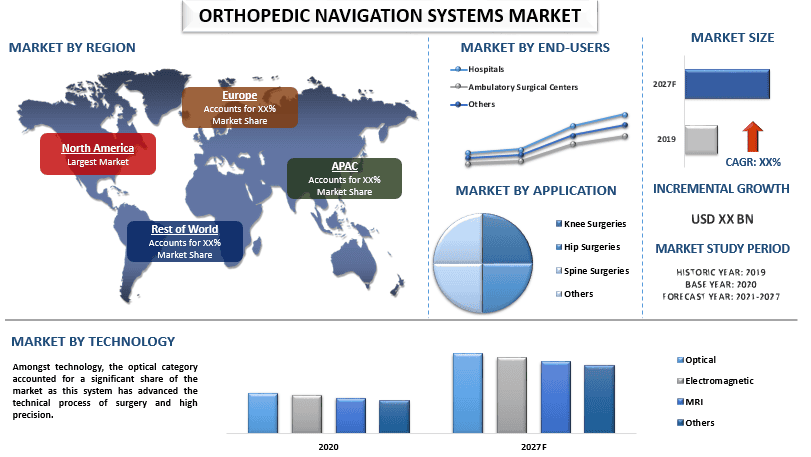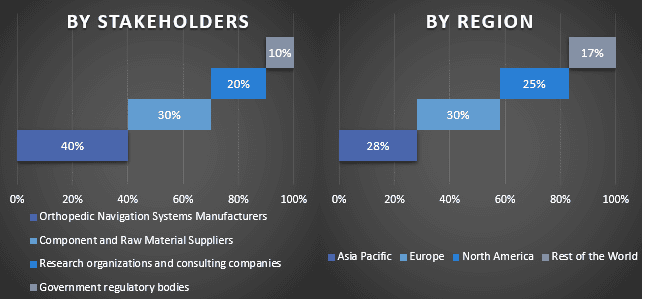
预计骨科导航系统市场在2021-2027年期间将以约9%的复合年增长率增长。预计骨科导航系统市场在2021-2027年期间将以约9%的复合年增长率增长。骨科导航系统最初于10多年前用于骨科脊柱手术,以提高椎弓根螺钉植入的效率。此后,它已被骨科医生广泛接受,并已成为多种骨科手术的宝贵工具,包括髋关节和膝关节重建、运动损伤、创伤以及脊柱和肿瘤手术。此外,传统技术可能缺乏准确性、精确性和可重复性。因此,对新型骨科导航系统的开发需求不断增加。全球骨科导航系统市场预计将随着社会发展而出现增长,导致饮食和其他生活方式的改变,从而损害人体骨骼。 加上全球人口迅速老龄化,导致肥胖患者数量增加。根据美国健康信托基金的说法, 在2020年, 美国的成年人肥胖率为42.4%,这是该国首次超过40%的肥胖率,进一步证明了该国的肥胖危机。由于这些明显的统计数据,预计骨科导航系统的需求将在未来几年内增长,因为肥胖会导致骨骼调节激素改变、氧化应激和炎症增加,以及骨细胞代谢改变,从而损害骨骼内部。此外,骨科手术数量的增加以及关节炎和骨质疏松症等骨科问题的发病率上升,预计将推动未来几年骨科导航系统市场的增长。
骨科导航系统日益普及的原因可归因于骨质疏松症、骨关节炎和类风湿性关节炎等各种骨相关疾病的患病率上升,以及老年人口的迅速增长。例如,根据国际骨质疏松症基金会的最新统计数据,全球范围内,50岁以上的女性中有三分之一,男性中有五分之一会在其一生中经历骨质疏松性骨折。5400万美国人,占50岁及以上所有成年人的一半,面临骨折的风险,应该关注骨骼健康。
- Braun Melsungen AG、Stryker、Medtronic、Smith+Nephew、Johnson & Johnson Services, Inc. (DePuy Synthes)、Zimmer Biomet、Amplitude Surgical、Kinamed, Inc.、Globus Medical、OrthAlign 是市场中的一些主要参与者。这些参与者已进行了一些并购和合作,以向客户提供高科技和创新产品/技术。
报告中呈现的见解
“在技术方面,光学类别在2020年占据了市场的大部分份额”
根据技术,市场分为电磁、光学、MRI 和其他。在技术方面,光学类别占据了市场的重要份额。该系统推进了手术的技术流程,并为复杂干预铺平了道路,因为它建立在具有高精度的立体视觉原理之上。因此,这些系统被应用于需要非常高精度和宽大访问路径的医疗程序。从而推动了这一细分市场的增长。
“在应用方面,便携式预计将在预测期内见证最高的复合年增长率”
根据应用,市场分为膝关节手术、髋关节手术、脊柱手术和其他。其中,膝关节手术预计将在预测期内见证最高的复合年增长率。与膝关节置换数量增加相关的益处意识增强是促成其增长的因素。此外,它在多种外科疾病中具有广泛的应用,包括全膝关节置换术、单间室(部分)膝关节置换术、膝关节置换术(髌股关节置换术)和改良膝关节置换术,这反过来又推动了该市场细分市场的增长。
“在最终用户方面,医院预计将在预测期内见证最高的复合年增长率”
根据最终用户,市场分为医院、门诊手术中心和其他。其中,医院预计将在预测期内见证最高的复合年增长率。医院在疼痛管理和骨科手术方面提供了广泛的治疗方案。此外,现代医疗设备的配备以及这些机构患者数量的增加是推动这一细分市场增长的因素。
“北美地区预计将在预测期内实现显著增长”
为了更好地理解骨科导航系统市场的市场动态,我们对全球不同地区进行了详细分析,包括北美(美国、加拿大和北美其他地区)、欧洲(德国、法国、西班牙、英国、意大利和欧洲其他地区)、亚太地区(中国、印度、澳大利亚、日本和亚太其他地区)、世界其他地区。 由于该地区拥有强大的医疗保健基础设施和骨科导航系统日益普及,北美是2020年骨科导航系统市场行业的主要市场。
购买本报告的原因:
- 该研究包括经过认证的关键行业专家验证的市场规模和预测分析。
- 该报告快速概览了整个行业的表现。
- 该报告涵盖了对主要行业同行的深入分析,主要侧重于关键的业务财务、产品组合、扩张战略和近期发展。
- 对行业中普遍存在的驱动因素、限制因素、主要趋势和机会的详细考察。
- 该研究全面涵盖了不同细分市场的市场。
- 对该行业的深入区域级分析。
定制选项:
全球骨科导航系统市场可以根据需求或任何其他市场细分进一步定制。除此之外,UMI 了解您可能拥有自己的业务需求,因此请随时与我们联系以获取完全适合您需求的报告。
目录
全球骨科导航系统市场分析的研究方法(2021-2027)
分析历史市场、估算当前市场以及预测全球骨科导航系统市场的未来市场,是创建和分析主要地区全球骨科导航系统采用情况的三个主要步骤。进行了详尽的二手研究以收集历史市场数据并估算当前市场规模。其次,为了验证这些见解,考虑了大量的发现和假设。此外,还对全球骨科导航系统市场的价值链中的行业专家进行了详尽的一手访谈。在通过一手访谈对市场数据进行假设和验证后,我们采用了自上而下/自下而上的方法来预测完整的市场规模。此后,采用了市场细分和数据三角测量方法来估算和分析与行业相关的细分市场和子细分市场的市场规模。详细的方法在下面解释:
历史市场规模分析
步骤1:深入研究二手资料来源:
进行了详细的二手研究,通过公司内部来源(如)获得骨科导航系统市场的历史市场规模年度报告和财务报表、业绩演示、新闻稿等,以及外部来源,包括期刊、新闻和文章、政府出版物、竞争对手出版物、行业报告、第三方数据库和其他可靠出版物。
步骤2:市场细分:
在获得骨科导航系统市场的历史市场规模后,我们进行了详细的二手分析,以收集主要地区不同细分市场和子细分市场的历史市场见解和份额。报告中包含的主要细分市场包括技术、应用和最终用户。进一步进行国家级分析,以评估该地区测试模型的总体采用情况。
步骤3:因素分析:
在获得不同细分市场和子细分市场的历史市场规模后,我们进行了详细的因素分析以估算骨科导航系统市场的当前市场规模。此外,我们使用各种技术、应用和骨科导航系统最终用户等因变量和自变量进行了因素分析。考虑到全球骨科导航系统市场行业的顶级合作、并购、业务扩张和产品发布,对供需情况进行了全面分析。
当前市场规模估算与预测
当前市场规模测算:基于上述3个步骤的可操作见解,我们得出了当前的市场规模、全球骨科导航系统市场的主要参与者以及各细分市场的市场份额。所有必需的百分比份额拆分和市场细分均使用上述二手方法确定,并通过一手访谈进行了验证。
估算与预测:对于市场估算和预测,为不同的因素分配了权重,包括驱动因素和趋势、限制因素以及利益相关者可用的机会。在分析了这些因素之后,采用了相关的预测技术,即自上而下/自下而上的方法,以得出2027年全球主要市场不同细分市场和子细分市场的市场预测。用于估算市场规模的研究方法包括:
- 就国内主要市场而言,该行业在收入(美元)方面的市场规模以及骨科导航系统市场的采用率
- 市场细分和子细分的所有百分比份额、拆分和细分
- 全球骨科导航系统市场中主要参与者的解决方案。此外,这些参与者为争夺快速增长的市场而采取的增长策略
市场规模和份额验证
初步研究:与主要地区的关键意见领袖 (KOL)(包括高层管理人员 (CXO/VP、销售主管、营销主管、运营主管、区域主管、国家主管等)进行了深入访谈。然后对初步研究结果进行总结,并进行统计分析以证明既定的假设。初步研究的输入与次要发现相结合,从而将信息转化为可操作的见解。
不同地区主要参与者的划分

市场工程
采用数据三角测量技术来完成整体市场估计,并得出全球骨科导航系统市场每个细分市场和子细分市场的精确统计数据。在研究了全球骨科导航系统市场中技术、应用和最终用户等各个领域的各种参数和趋势后,将数据细分为多个细分市场和子细分市场。
全球骨科导航系统市场研究的主要目标
研究确定了全球骨科导航系统市场的当前和未来市场趋势。投资者可以获得战略见解,从而根据研究中进行的定性和定量分析来决定投资。当前和未来的市场趋势决定了市场在区域层面的整体吸引力,为行业参与者提供了一个平台,可以利用未开发的市场,从而获得先发优势。研究的其他定量目标包括:
- 按价值(美元)分析骨科导航系统市场的当前和预测市场规模。此外,分析不同细分市场和子细分市场的当前和预测市场规模
- 研究中的细分市场包括技术、应用和最终用户领域
- 定义和分析骨科导航系统市场行业的监管框架。
- 分析涉及各种中介机构的价值链,以及分析行业的客户和竞争对手行为。
- 分析主要区域的骨科导航系统市场的当前和预测市场规模。
- 报告中研究的主要国家/地区包括亚太地区、欧洲、北美和世界其他地区。
- 骨科导航系统市场的公司概况以及市场参与者为维持在快速增长的市场中所采用的增长策略
- 行业深入的区域层面分析
相关 报告
购买此商品的客户也购买了










